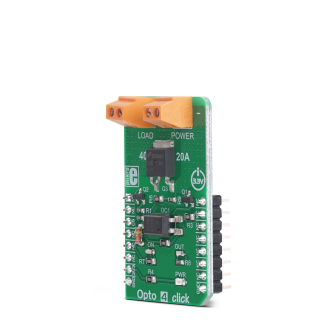
We strongly encourage users to use Package manager for sharing their code on Libstock website, because it boosts your efficiency and leaves the end user with no room for error. [more info]

Rating:
Author: MIKROE
Last Updated: 2019-02-06
Package Version: 1.0.0.0
mikroSDK Library: 1.0.0.0
Category: Optocoupler
Downloaded: 5157 times
Not followed.
License: MIT license
Opto 4 click is a galvanically isolated power switch, which uses a power MOSFET in combination with the optocoupler.
Do you want to subscribe in order to receive notifications regarding "Opto 4 click" changes.
Do you want to unsubscribe in order to stop receiving notifications regarding "Opto 4 click" changes.
Do you want to report abuse regarding "Opto 4 click".


Library Description
The library contains a function for enabling or disabling the output voltage.
Key functions:
void opto4_outputEnable(uint8_t enable) - Function for output enable or disable.Examples description
The application is composed of the three sections :
void applicationTask()
{
opto4_outputEnable(_OPTO4_OUTPUT_ENABLE);
Delay_ms( 3000 );
opto4_outputEnable(_OPTO4_OUTPUT_DISABLE);
Delay_ms( 3000 );
}
Other mikroE Libraries used in the example:
GPIOAdditional notes and informations
Depending on the development board you are using, you may need USB UART click, USB UART 2 clickor RS232 click to connect to your PC, for development systems with no UART to USB interface available on the board. The terminal available in all MikroElektronika compilers, or any other terminal application of your choice, can be used to read the message.